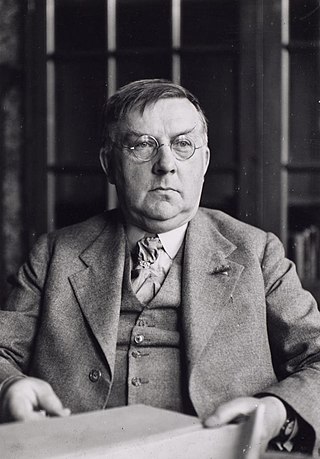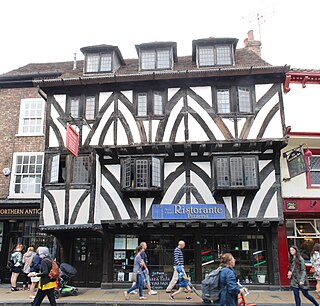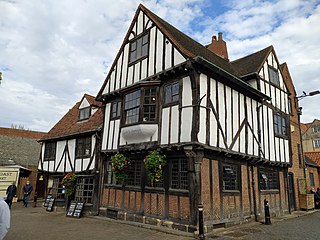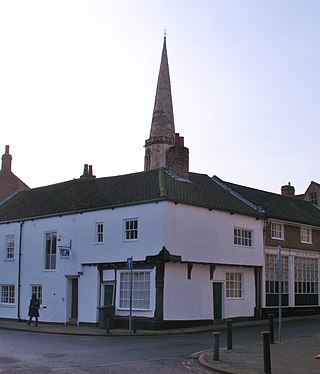
York has, since Roman times, been defended by walls of one form or another. To this day, substantial portions of the walls remain, and York has more miles of intact wall than any other city in England. They are known variously as York City Walls, the Bar Walls and the Roman walls. The walls are generally 13 feet (4m) high and 6 feet (1.8m) wide.They are the longest town walls in England.
York had around 45 parish churches in 1300. Twenty survive, in whole or in part, a number surpassed in England only by Norwich, and 12 are used for worship. This article consists of a list of medieval churches which still exist in whole or in part, and a list of medieval churches which are known to have existed in the past but have been completely demolished.

The Mansion House in York, England is the home of the Lord Mayors of York during their term in office. It is situated in St Helen's Square, where York's Coney Street and Lendal intersect in the city centre. It is built in an early Georgian style. The Mansion House is the earliest purpose-built house for a Lord Mayor still in existence, and predates the Mansion House in London by at least twenty years.

The Old Hall Hotel is a public house and restaurant in High Street, Sandbach, Cheshire, England. It was built in 1656 on the site of a previous manor house, and since been extended. In the 18th century it was used as a coaching inn and hotel. It closed as a hotel in 2005; it was unused for four years, and its fabric suffered serious deterioration. In 2010 the building was bought by Brunning and Price, a subsidiary of the Restaurant Group, who repaired and restored it. It was reopened as a public house and restaurant in 2011. The building is timber-framed, and is recorded in the National Heritage List for England as a designated Grade I listed building.

Stoneacre is a small National Trust property in Otham, near Maidstone, Kent in southern England. The property is a half-timbered yeoman farmer's house dating from the 15th century, together with a small garden, orchard and meadows. The house is a Grade II* listed building.

John Bowes Morrell (1873–1963) was an English historian and writer. He was twice Lord Mayor of York, a leading figure in the local movement to establish a university in York, and founder of the York Conservation Trust. The J.B. Morrell Library at the University of York is named after him.
The York Conservation Trust is a trust that buys and restores significant historical buildings in York, England, and then makes them available to rent.

St Anthony's Hall in York, England, is a former medieval guildhall and Grade I listed building. It currently houses Trinity Church York and the Quilt Museum and Gallery. The Hall, located on Peasholme Green, was built between 1446 and 1453 on the site of a chapel of St Anthony for either the Guild of St Martin or the Guild of St Anthony. After the decline of the Guilds, it was used between 1627 and 1705 for various purposes: as an arsenal, a military hospital and a prison. Between 1705 and 1947 it housed the York Bluecoat School, after which it was offered to the York Civic Trust. In 1953, it became the Borthwick Institute for Historical Research, which moved in 2004 to a purpose-built building next to the J. B. Morrell Library on the campus of the University of York. The Quilt Museum and Gallery opened in the Hall in 2008 and closed in 2015.

St John the Evangelist's Church is a redundant Anglican church in North Road, Lancaster, Lancashire, England. It is recorded in the National Heritage List for England as a designated Grade II* listed building, and is under the care of the Churches Conservation Trust.

Moulsecoomb Place is a large 18th-century house on Lewes Road in the Moulsecoomb area of the English coastal city of Brighton and Hove. Originally a farmhouse based in an agricultural area in the parish of Patcham, north of Brighton, it was bought and extensively remodelled in 1790 for a long-established local family. It was their seat for over 100 years, but the Neoclassical-style mansion and its grounds were bought by the local council in the interwar period when Moulsecoomb was transformed into a major council estate. Subsequent uses have varied, and Moulsecoomb Place later became part of the University of Brighton's range of buildings. Student housing has been built to the rear; but much of the grounds, the house itself and a much older cottage and barn attached to the rear have been preserved. The house is a Grade II Listed building.

Sir Thomas Herbert's House, often known as Herbert House, is a Grade I listed building in York, dating from the 16th and 17th centuries.

The Wealden Hall is a grade I listed building on Goodramgate in the city centre of York, in England.

Walmgate is a street in the city centre of York, in England. During the Medieval period, the street was the site of a seafish and cattle market. Walmgate Bar was involved in the Siege of York in 1644, during the First English Civil War. During the 20th century, many of the older buildings were cleared away and newer structures put up.

41–45 Goodramgate is a grade I listed building in the city centre of York, in England.

Bedern is a street in the city centre of York, in England, which originated as a college for the vicars choral of York Minster.

The Black Swan is a public house in the city centre of York, in England. The building lies on Peasholme Green, on the site of an important Mediaeval house which had been occupied by various Lord Mayors of York and Members of Parliament. In 1560, Martin Bowes rebuilt the property, and in 1670 Henry Thompson made substantial alterations, rebuilding parts in brick, and altering the interior. Early in the 18th-century, the house was owned by Edward Thompson.

The Red Lion is a pub in the city centre of York, in England.

2 Jubbergate, also known as 4 Jubbergate, is a grade II* listed building in the city centre of York, in England.

77 Walmgate is a timber framed building in the city centre of York, in England.

1 Tanner Row is a historic building in the city centre of York, in England.


















